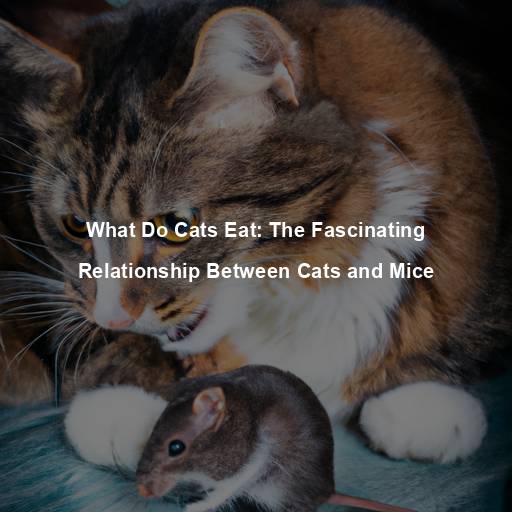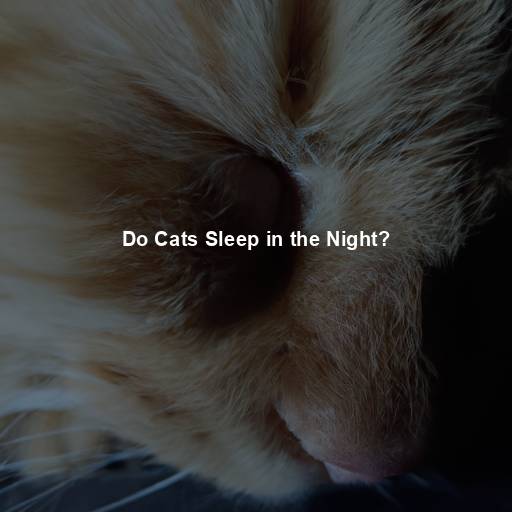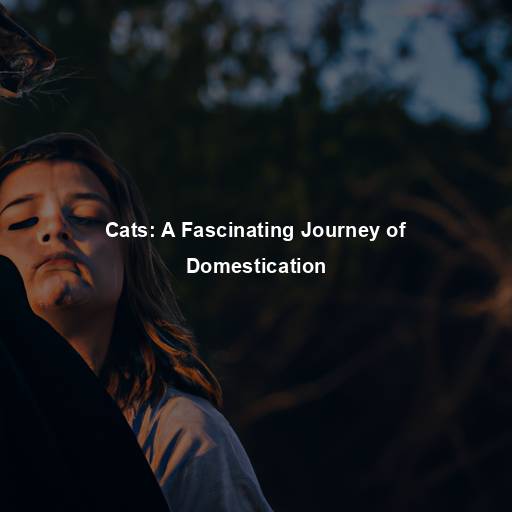What Do Cats Eat: The Fascinating Relationship Between Cats and Mice
Last Updated on November 4, 2023 by Evan
Contents
- 1 Understanding the Natural Instincts of Cats
- 1.1 The Hunting Instinct: An Evolutionary Trait
- 1.2 Nutritional Benefits of Mice in a Cat’s Diet
- 1.3 Cats and Mice: A Game of Chase
- 1.4 Domestic Cats: Natural Pest Controllers
- 1.5 The Dangers of Mice for Cats
- 1.6 Balancing a Cat’s Diet: Commercial Cat Food
- 1.7 Encouraging Natural Behavior
- 1.8 A Dance of Survival
- 2 The Significance of Play in Hunting
- 3 The Role of Diet in a Cat’s Health
- 4 Responsible Cat Ownership and Ethical Considerations
- 5 FAQs – What Cats Eat Mice
Understanding the Natural Instincts of Cats
Cats have long been known for their hunting prowess, and one of their primary prey animals is the humble mouse. This natural instinct to hunt and capture mice is deeply ingrained in their DNA, as cats are descendants of wild feline predators. In this article, we will explore the fascinating relationship between cats and mice, delving into what cats eat and the reasons behind their love for hunting these small rodents.
The Hunting Instinct: An Evolutionary Trait
Cats are born with a strong hunting instinct, which is a result of their evolutionary history. Their ancestors, wild cats, relied on hunting for survival. This instinct has been passed down through generations, making domestic cats exceptional hunters. Mice, being small and agile creatures, provide the perfect prey for cats to exercise their natural hunting skills.
Nutritional Benefits of Mice in a Cat’s Diet
Did you know that besides being a feline’s ultimate hunting target, mice can actually provide some surprising health benefits? These tiny vermin pack quite the nutritional punch! Mice are loaded with protein, a vital component for cats’ growth, tissue repair, and immune system. And that’s not all – they also provide essential fatty acids, vitamins, and minerals that contribute to a well-rounded diet for our furry friends.
Cats and Mice: A Game of Chase
The chase between cats and mice is an endless game that never fails to captivate our attention. Cats exhibit remarkable agility, stealth, and patience when stalking their prey. They exhibit a characteristic behavior called “creeping and pouncing,” where they crouch low, slowly inching towards their target, and then launch into a swift pounce to catch the mouse. This behavior is instinctual and showcases the incredible athleticism of our feline companions.
Domestic Cats: Natural Pest Controllers
In addition to being beloved companions, cats have long been employed for their exceptional pest control abilities. Farmers, for instance, have utilized cats to keep their barns and crops free from rodents such as mice. This symbiotic relationship between humans and cats dates back centuries, as cats have proven to be highly efficient in reducing vermin populations.
The Dangers of Mice for Cats
While mice may be a natural prey for cats, it’s essential to understand the potential risks associated with this interaction. Mice can carry diseases and parasites, which can be transmitted to cats through hunting and consumption. It is crucial to ensure that your cat’s prey, whether it be mice or other small creatures, are free from any harmful pathogens.
Balancing a Cat’s Diet: Commercial Cat Food
Ensuring your feline companion stays fit and fab is no cakewalk. You might think letting them roam and prey on unsuspecting critters would suffice, but hold your horses! Experts agree that serving up a nutritionally balanced meal is the way to go. Those savvy folks in the pet food industry have concocted a nifty formula chock-full of all the goodies your whiskered wonder needs to remain in tip-top shape.
Encouraging Natural Behavior
In today’s domesticated world, cats may not need to hunt for survival, but their innate instincts still deserve attention. Embracing their natural behaviors becomes crucial, and interactive toys act as the perfect gateway. Feather wands and treat-dispensing puzzles not only satiate their hunting instincts but also offer a safe and controlled outlet for their energy. The added bonus is that these engaging activities enhance the bond you share with your feline friend while stimulating their sharp minds.
A Dance of Survival
Step into the mesmerizing realm of the feline and rodent, where a delicate tango of survival ensues. Mesmerized by the mystifying dance unfolding before our eyes, we witness the ballet of existence. With their razor-sharp instincts and untamed prowess, cats reign as nature’s formidable predators. In turn, nimble mice, adorned with swift reflexes and elusive finesse, become the masters of evasion.
The Mice’s Defense Mechanisms
In the intricate dance of the animal kingdom, mice have choreographed their survival with elusive moves. Through countless generations, they have refined their sensory prowess, developing an acute sense of hearing that can detect the faintest whisper of an encroaching feline. Their bodies, molded through evolution’s whims, are pliable and nimble, enabling them to slip through the tiniest of crevices, like mystical creatures traversing unseen realms. And as if casting a fragrant enchantment, these adept little beings emit a distinctive scent, a secret alarm to ward off lurking feline predators and unknown dangers alike.
The Cat’s Hunting Techniques
Cats are truly remarkable creatures when it comes to hunting. Mysterious and intriguing, they possess an array of sophisticated techniques to capture their elusive prey. Their heightened sense of hearing, combined with their keen eyesight, enables them to detect the faintest movements of a mouse. Moreover, their delicate whiskers serve as powerful tools, helping them navigate through the darkness while accurately assessing the size and position of their target.
The Significance of Play in Hunting
Play: A Learning Experience
Play is an integral part of a cat’s development and serves a crucial role in honing their hunting skills. When kittens engage in playful activities such as pouncing, stalking, and chasing toys, they are essentially practicing the skills they will later use when hunting real prey. Through play, cats learn to judge distances, improve their coordination, and refine their natural instincts.
The Role of Toys in Play
Explore the captivating world of feline stimulation with an enchanting array of toys designed to awaken your cat’s inner hunter. Delve into the realm of play and adventure as your feline friend embarks on a mesmerizing journey of chasing, pouncing, and capturing elusive prey. Dive into the perplexing realm of interactive toys, where mental acuity and physical agility intertwine, simulating the exhilaration of a real hunt. Feed their insatiable need for stimulation with toys that mimic the lifelike movements and captivating sounds of small creatures, igniting their primal instincts and unleashing their inner predator.
The Importance of Environmental Enrichment
When it comes to your feline friend, it’s all about crafting an environment that nourishes their inner wildcat. Think beyond the ordinary and embrace the extraordinary, because a bored cat is a perplexed cat. Give them a taste of the jungle with towering cat trees, scratching posts fit for a fearless feline, and mind-boggling puzzle toys that will ignite their curiosity. Embrace the burstiness of their instincts and let them explore, climb, and hide in their very own feline utopia.
The Role of Diet in a Cat’s Health
Meeting Nutritional Needs
While cats have a natural instinct to hunt and eat mice, it is important to remember that they require a balanced and nutritionally complete diet to thrive. Commercial cat food is specially formulated to provide all the essential nutrients, vitamins, and minerals that cats need for optimal health. These diets are carefully designed to meet the unique nutritional requirements of cats at different life stages, ensuring they receive the right balance of proteins, fats, carbohydrates, and micronutrients.
The Dangers of a Mouse Diet
Considering the well-being of your feline companion, it’s important to tread cautiously when it comes to their meal choices. Although a seemingly natural instinct for cats, relying solely on a diet of mice can bring about a perplexing array of potential risks. These hitchhiking maladies and pesky critters can hitch a ride into your furball’s system, causing a rather tumultuous situation. To avoid throwing the delicate balance of your cat’s nutrition out of whack, seeking the advice of your friendly neighborhood veterinarian is highly recommended.
The Importance of Hydration
When it comes to cats, hydration can be a tricky tale. These mysterious creatures have a whimsical relationship with thirst, often leaving you perplexed and scratching your head. But fear not, dear pet parent! The key to keeping your feline friend wet-pawed and hydrated is to provide a constant flow of fresh, clean water, as well as incorporating wet or canned food into their diet.
Responsible Cat Ownership and Ethical Considerations
The Ethics of Allowing Cats to Hunt
The ethical dilemma surrounding the hunting habits of our feline companions continues to bewilder and perplex both pet enthusiasts and animal activists alike. On one hand, we cannot ignore the fact that hunting is an inherent instinct ingrained in cats since time immemorial. Yet, the ramifications on our fragile wildlife populations, especially in areas teeming with vulnerable indigenous species, cannot be underestimated. It is incumbent upon cat guardians to grapple with the complex conundrum and analyze the ecological repercussions of their pets’ predatory pursuits, exploring potential solutions like indoor confinement or secure outdoor enclosures.
Balancing a Cat’s Natural Instincts with Responsible Ownership
Responsible cat ownership involves striking a balance between allowing cats to express their natural behaviors while also ensuring their safety and minimizing their impact on the environment. Providing environmental enrichment, engaging in interactive play, and offering a nutritionally complete diet are all ways to meet a cat’s needs while keeping them content and fulfilled.
Alternatives to Hunting
Calling all cat enthusiasts! If you find yourself in the company of a feline friend who prefers to play indoors or if you reside in an environment that isn’t exactly conducive to unfettered roaming, fear not. There exists a bountiful array of options to captivate your cat’s innate hunter’s spirit. Innovative interactive toys, captivating puzzle feeders, and even personalized play sessions can satiate those primal instincts, all while fostering mental acuity, promoting physical wellness, and forging an unbreakable bond between you and your four-legged companion.
FAQs – What Cats Eat Mice
What do cats eat besides mice?
Cats are carnivorous animals, which means their diet primarily consists of meat. Besides mice, cats commonly eat other small rodents such as rats, voles, and squirrels. They also enjoy hunting and consuming birds, insects, and even small reptiles like lizards or snakes. However, in domesticated settings, most cats are fed commercially prepared cat food that offers a balanced diet to meet their nutritional requirements.
Are cats obligate mouse eaters?
Cats, those enigmatic creatures of instinct and charm, possess an undeniable prowess for hunting, with mice being among their favored targets. Yet, they are not bound by any strict dietary codes that command them to exclusively indulge in these furry delicacies. In the comforts of our modern homes, our feline friends are blessed with a myriad of commercially concocted cat foods, meticulously crafted to provide them with all the essential nutrients for a life of vitality. It is true that some cats, driven by their ancestral urges, may revel in the thrill of the chase and indulge in the occasional mouse feast, but it is by no means a prerequisite for their survival. Each feline individual, guided by their unique circumstances and innate hunting prowess, will independently decide whether to seize the opportunity to hunt and devour mice or let their bellies be satiated by other delectable options.
Why do cats eat mice?
Cats have a strong predatory instinct, and hunting is a fundamental behavior for them. The chase, capture, and consumption of mice provide mental stimulation and an outlet for their natural instincts. Additionally, hunting and eating mice can be satisfying for cats, as it taps into their ancestral behavior and provides a sense of accomplishment. In some cases, cats may also eat mice to supplement their diet with fresh prey, especially if they lack certain nutrients.
Is it safe for cats to eat mice?
When it comes to the age-old query of whether cats can munch on mice, the answer is as complicated as deciphering a cryptic puzzle. While felines have undoubtedly honed their skills as expert hunter-gatherers over millennia, their recent reliance on processed cat cuisine casts a shadow of uncertainty. The delicate intricacies of their digestive systems and the potential lurking dangers of infectious critters make this topic a maze of perplexing possibilities. Seeking guidance from a knowledgeable veterinarian will pave a clearer path towards ensuring the well-being and security of your whiskered friend when it comes to dining on these petite prey.
Do cats need to eat mice?
Contrary to popular belief, feline nutrition has come a long way, my friends. Though the sight of a cat joyously pouncing on a hapless mouse might conjure up images of primitive instincts in action, the truth is that our modern-day domestic felines can live a thriving life without resorting to rodent-based menus. Fear not, clever cat guardians, for the realm of scientifically formulated cat food awaits, a bountiful feast designed to nourish their discerning palates and cater to their every nutritional need. So, put away those mice-catching dreams and focus on providing a well-balanced diet that will keep your feline companions purring with contentment and vitality.






